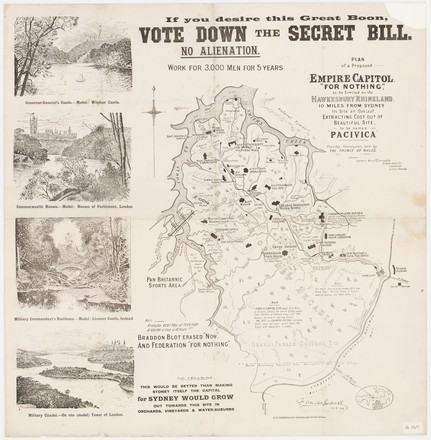
Plan of a proposed Empire capitol "for nothing" to be erected on the Hawkesbury Rhineland 10 miles from Sydney, its site an oak leaf, extracting cost out of beautiful site to be named Pacivica
1899
Printed map
Bequest of Sir William Dixson, 1952
DL Z/Cb 89/7
Printed map
Bequest of Sir William Dixson, 1952
DL Z/Cb 89/7
Following the decision in 1890 to federate the Australian colonies, the continent was quickly awash with ideas and proposals for the new federal capital. This idea for an empire capital of ‘Pacivica’ on the banks of the Hawkesbury in what is now Ku-ring-gai Chase was developed and passionately promoted by Sydney surveyor and engineer F Oliver Jones. Within his ‘City Beautiful’ a model ‘empire-building’ community would be ‘shaped on new yet British lines’.*
His proposal, however, slipped from possibility with the defeat in NSW of the 1898 federation referendum: as a sweetener to the people of NSW, the Constitution was altered to require the capital be in NSW, but at least 100 miles (161km) from Sydney. Pacivica was no longer in contention.


 Back to list
Back to list